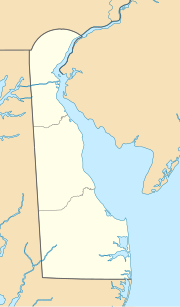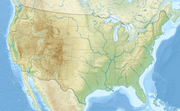Bundicks Branch (Love Creek tributary)
| Bundicks Branch Tributary to Love Creek | |
|---|---|
 | |
| Location | |
| Country | United States |
| State | Delaware |
| County | Sussex |
| Physical characteristics | |
| Source | Simpler Branch divide |
| • location | about 0.5 miles west of Anderson Corner |
| • coordinates | 38°42′00″N 075°16′48″W / 38.70000°N 75.28000°W[1] |
| • elevation | 42 ft (13 m)[2] |
| Mouth | Love Creek |
• location | Goslee Millpond |
• coordinates | 38°43′06″N 075°11′25″W / 38.71833°N 75.19028°W[1] |
• elevation | 3 ft (0.91 m)[2] |
| Length | 7.01 mi (11.28 km)[3] |
| Basin size | 7.00 square miles (18.1 km2)[4] |
| Discharge | |
| • average | 8.31 cu ft/s (0.235 m3/s) at mouth with Love Creek[4] |
| Basin features | |
| Progression | generally east |
| River system | Rehoboth Bay |
| Tributaries | |
| • left | unnamed tributaries |
| • right | unnamed tributaries |
| Bridges | Rust Road Harbeson Road Cool Spring Road Hopkins Road DE 23 |
Bundicks Branch is a 7.01 mi (11.28 km) long 1st order tributary to Love Creek, in Sussex County, Delaware.
Variant names[]
According to the Geographic Names Information System, it has also been known historically as:[1]
- Bundick's Creek
Course[]
Bundicks Branch rises on the Simpler Branch divide about 0.5 miles west of Anderson Corner in Sussex County, Delaware. Bundicks Branch then flows generally east to meet Love Creek within Goslee Millpond.[2]
Watershed[]
Bundicks Branch drains 7.00 square miles (18.1 km2) of area, receives about 45.2 in/year of precipitation, has a topographic wetness index of 640.38 and is about 27.7% forested.[4]
See also[]
References[]
- ^ a b c "GNIS Detail - Bundicks Branch". geonames.usgs.gov. US Geological Survey. Retrieved 17 February 2020.
- ^ a b c "Bundicks Branch Topo Map, Sussex County DE (Fairmount Area)". TopoZone. Locality, LLC. Retrieved 17 February 2020.
- ^ "ArcGIS Web Application". epa.maps.arcgis.com. US EPA. Retrieved 17 February 2020.
- ^ a b c "Bundicks Branch Watershed Report". Waters Geoviewer. US EPA. Retrieved 17 February 2020.
Categories:
- Rivers of Delaware
- Northeastern United States river stubs
- Delaware geography stubs


